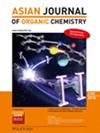Bioassay‐Guided Extraction and Isolation of Natural Herbicides from Dried Zanthoxylum limonella Alston Fruits
IF 2.8
4区 化学
Q1 CHEMISTRY, ORGANIC
引用次数: 0
Abstract
Weeds are problematic plant species around the world. Various strategies exist for controlling weeds, but chemical treatment remains the preferred method, particularly when using natural substances. In this research, a crude aqueous‐methanol extract from dried Zanthoxylum limonella fruits was acid‐base partitioned into four fractions: neutral extract (NE), acid extract (AE), basic extract (BE), and aqueous extract (AQ). These fractions were further separated into seventeen subfractions: NEF1 to NEF7, AEF1 to AEF5, and BEF1 to BEF5, which were then tested for herbicidal activity against the growth of Chinese amaranth (Amaranthus tricolor) and barnyard grass (Echinochloa crus‐galli). Active subfractions were isolated via column chromatography and identified using spectroscopic methods, yielding seven active compounds: xanthoxyline (1), tambulin (2), atanine (3), prudomestin (4), skimmianine (5), p‐methoxybenzoic acid (6), and methyl caffeate (7). Compounds 2–7 had not been previously reported in Z. limonella. Xanthoxyline (1) was identified as the most potent botanical herbicide, fully inhibiting seed germination of Chinese amaranth and barnyard grass. This compound also decreased seed imbibition and α‐amylase activity in both species. Molecular docking studies on the α‐amylase enzyme (PDB ID: 1BG9) revealed that the aromatic, hydroxy, and carbonyl groups of xanthoxyline (1) interact with the enzyme's active sites.

求助全文
约1分钟内获得全文
求助全文
来源期刊

Asian Journal of Organic Chemistry
CHEMISTRY, ORGANIC-
CiteScore
4.70
自引率
3.70%
发文量
372
期刊介绍:
Organic chemistry is the fundamental science that stands at the heart of chemistry, biology, and materials science. Research in these areas is vigorous and truly international, with three major regions making almost equal contributions: America, Europe and Asia. Asia now has its own top international organic chemistry journal—the Asian Journal of Organic Chemistry (AsianJOC)
The AsianJOC is designed to be a top-ranked international research journal and publishes primary research as well as critical secondary information from authors across the world. The journal covers organic chemistry in its entirety. Authors and readers come from academia, the chemical industry, and government laboratories.
 求助内容:
求助内容: 应助结果提醒方式:
应助结果提醒方式:


